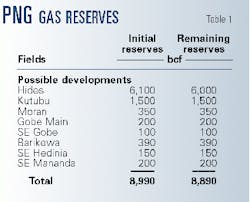Queensland's new energy policy pushes proposed Papua New Guinea pipeline
In May, the government of Queensland, Australia, issued details of a new energy policy that will have a positive impact on the proposed 1,988-mile, New Guinea-Queensland gas pipeline.
The Queensland Energy Policy, created to reduce greenhouse-gas emissions, strongly supports increased use of natural gas in Queensland while penalizing continued coal use, according to a new Wood Mackenzie status report on the project.
The action is the latest in a string of events leading to a stronger probability that the pipeline will be constructed, the Edinburgh-based WoodMac says. If built, the pipeline will boost the economies of both Papua New Guinea and Queensland.
Although the governments of Papua New Guinea, Australia, and Queensland all favor the project and have signed a memorandum of understanding supporting construction of the pipeline and ancillary facilities, financing is not yet fully in place, says WoodMac.
"Capital investment [for the total project] is expected to reach $8.1 billion (Aus.)," said Jim Elder, Queensland's deputy premier and minister for state development, in summer 1999 in a statement supporting the project. "The pipeline and associated projects will deliver an estimated 5,100 construction jobs and 2,500 operational jobs," he added.
Developer Chevron Services Australia Pty. Ltd., meanwhile, has secured gas sales agreements for market volumes of 66.5 bcf/year, sufficient to support the project (OGJ, Sept. 7, 1998, p. 38). The agreements await final approvals.
A major project
The $3.5 billion pipeline system, $2.5 billion of which will finance delivery facilities in Queensland, is designed to deliver up to 600 MMcfd of natural gas to new markets there. Supplies will come from Papua New Guinea's southern highlands fields, which contain reserves totaling 8.99 tcf (see table).
The 18, 22, and 30-in. pipeline system includes a wet gas line from the fields to an offshore processing plant in the Gulf of Papua, where LPG will be separated for both domestic and export use.
From the plant, dry gas will be piped across the Torres Strait to Cape York and down to Comalco Ltd.'s proposed $1.4 billion gas-powered alumina plant and other markets in Gladstone.
A short lateral to Townsville, on the coast north of Gladstone, will supply Stanwell Corp.'s proposed gas-fired power station, and a 286-mile extension to Brisbane is under discussion and will probably follow later.
Supportive energy policies
The new Queensland energy policies stem from the 1997 Kyoto agreement, when Australia agreed to contain greenhouse-gas emissions to no more than 8% above 1990 levels by 2008-12.
Under this mandate, Queensland plans to spend more than $50 million during the next 5 years on programs supporting renewable and innovative energy technologies and facilitating the abundant supply of competitively priced gas.
To reduce the growth of greenhouse emissions, the state will no longer issue licenses for coal-fired power stations, WoodMac says. The new regulations require substituting natural gas for coal as fuel for new electric power generation plants that the state will facilitate.
For example, the government will construct a new power station in Townsville by 2002 (or support the conversion of one or more existing peaking power stations to natural gas and base-load operation) if gas is successfully introduced into the area by then.
The base load power station at Townsville would require about 36 MMcfd of gas, which initially could come from the Cooper basin or from coal-bed methane fields in the Bowen basin until the PNG pipeline is built.
The government and operators of the Australian pipeline section-Australian Gas Light Co. and Malaysian state oil firm Petronas-have agreed to complete the construction of the 421-mile Gladstone-Townsville pipeline section by mid-2002.
The government is prepared to contribute financially to that segment's construction, WoodMac says. Overall cost of this section is estimated at $350 million in 2000 terms.
And beginning Jan. 1, 2005, licenses for electricity retailers operating in Queensland will require that at least 15% of their electricity sales come from gas-fired sources or 2% from renewable sources.
Because gas is not competitive with coal, the energy policy draws heavily on the potential impact of carbon taxes to create competition and reduce greenhouse gas emissions. A discriminatory tax on carbon dioxide emissions would significantly improve the economics of gas as a fuel source for power generation, WoodMac says.
If a $30 tax is levied per tonne of carbon produced, for example, emissions could be reduced by more than 30 million tonnes over 10 years, the government predicts, and it could save the state economy about $80 million/year.
